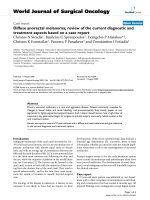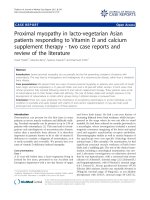Lecture Massage therapy review: Passing the NCETMB, NCETM, and MBLEx (2/e): Chapter 4 - Laura A. Abbott
Bạn đang xem bản rút gọn của tài liệu. Xem và tải ngay bản đầy đủ của tài liệu tại đây (831.22 KB, 21 trang )
Massage Therapy Review:
Passing the NCETMB, NCETM, and MBLEx
Chapter 4
Therapeutic Massage and Bodywork Assessment
McGrawHill
© 2011 by The McGrawHill Companies, Inc. All rights reserved
4-2
Preclass Assignment
• Review Chapter
4 of your
Massage Therapy
Review book
McGrawHill
© 2011 by The McGrawHill Companies, Inc. All rights reserved
4-3
Assessment Methods
• H.O.P.S
– History
– Observation
– Palpation
– Special Test
McGrawHill
© 2011 by The McGrawHill Companies, Inc. All rights reserved
4-4
Assessment Methods, Cont’d
• Visual Assessments
– Gait or Walking Patterns
– Posture
– Breathing Patterns
– Sympathetic or Parasympathetic
4-5
Normal Ranges of Motion
• Foot
– Dorsiflexion – 2030 degrees
– Plantarflexion – 3050 degrees
– Inversion – 50 degrees
– Eversion – 25 degrees
4-6
Normal Ranges of Motion, Cont’d
• Knee
– Flexion – 160 degrees
– Extension – 180 degrees
4-7
Normal Ranges of Motion, Cont’d
• Hip
– Flexion
• 90 degrees if knee is extended
• 120 degrees if knee is flexed
– Extension – 20 degrees
– Internal Rotation – 30 degrees
– External Rotation – 60 degrees
– Adduction – 30 degrees
– Abduction – 45 degrees
McGrawHill
© 2011 by The McGrawHill Companies, Inc. All rights reserved
4-8
Normal Ranges of Motion, Cont’d
• Trunk
– Flexion – 4060 degrees
– Extension – 35 degrees
– Lateral Flexion – 1520 degrees
– Rotation – 1015 degrees
McGrawHill
© 2011 by The McGrawHill Companies, Inc. All rights reserved
4-9
Normal Ranges of Motion, Cont’d
• Neck
– Flexion – 80 degrees
– Extension – 6070 degrees
– Lateral Flexion – 3545 degrees
– Rotation – 80 degrees
McGrawHill
© 2011 by The McGrawHill Companies, Inc. All rights reserved
4-10
Normal Ranges of Motion, Cont’d
• Shoulder
–
–
–
–
–
–
–
–
Flexion – 180 degrees
Extension – 4550 degrees
Abduction – 180 degrees
Adduction – 3045 degrees
Internal Rotation – 3045 degrees
External Rotation – 80 degrees
Horizontal Abduction – 30 degrees
Horizontal Adduction – 140 degrees
McGrawHill
© 2011 by The McGrawHill Companies, Inc. All rights reserved
4-11
Endangerment Sites
• Anterior Triangle of the Neck
– Common carotid arteries
– Hyoid
– Internal jugular vein
– Thyroid gland
– Trachea
– Vagus nerve
– Lymph nodes
McGrawHill
© 2011 by The McGrawHill Companies, Inc. All rights reserved
4-12
Endangerment Sites, Cont’d
• Posterior Triangle of the Neck
– Brachial plexus
– External jugular vein
– Facial nerve
– Subclavian artery
– Styloid process
– Lymph nodes
McGrawHill
© 2011 by The McGrawHill Companies, Inc. All rights reserved
4-13
Endangerment Sites, Cont’d
• Axillary
– Axillary arteries and nerves
– Brachial arteries and plexus
– Median nerves
– Musculotaneous nerve
– Radial and ulnar nerve
– Axillary lymph nodes
– Personal space
4-14
Endangerment Sites, Cont’d
• Antecubital Area of Elbow
– Brachial arter
– Cubital vein
– Median nerve
– Radial/ulnar arteries
McGrawHill
© 2011 by The McGrawHill Companies, Inc. All rights reserved
4-15
Endangerment Sites, Cont’d
• Femoral Triangle
– Femoral artery and nerve
– Great saphenous vein
– Obturator nerve
– Inguinal lymph nodes
McGrawHill
© 2011 by The McGrawHill Companies, Inc. All rights reserved
4-16
Endangerment Sites, Cont’d
• Lower Back
– Floating ribs
– Kidneys
4-17
Endangerment Sites, Cont’d
• Olecranon Process
– Ulnar nerve
– Radial nerve
4-18
Endangerment Sites, Cont’d
• Popliteal Fossa
– Common peroneal nerves
– Popliteal arteries
– Tibial nerves
McGrawHill
© 2011 by The McGrawHill Companies, Inc. All rights reserved
4-19
Postural Analysis
•
•
•
Client should be barefoot
Begin at head and work to the feet or vice versa
Check
– Feet
– Achilles
– Gastrocnemius
– Popliteal Fold
– Head
– Hips
– Spine
– Shoulders
McGrawHill
© 2011 by The McGrawHill Companies, Inc. All rights reserved
4-20
Understanding Kinesiology
•
•
•
•
Somatic holding patterns
Ergonomics
Proprioception
Gravity
4-21
Preventing Injuries to Ourselves as
Therapists and Bodyworkers
•
•
•
•
•
•
•
•
Table height
Comfortable clothing
Warmup and stretch
Variety of strokes
Pressure behind your strokes
Proper body mechanics
Breathe
Smooth movements
McGrawHill
© 2011 by The McGrawHill Companies, Inc. All rights reserved









